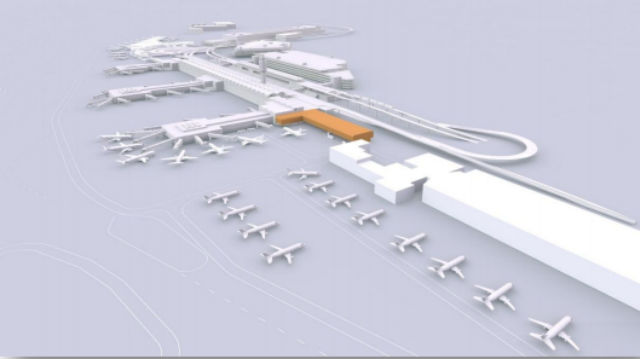The Metropolitan Washington Airports Authority (MWAA) is evaluating four options to expand terminal and landside facilities at Ronald Reagan Washington National airport, as it prepares for a surge in passenger numbers.
Possibilities include a new concourse or terminal north of the existing North Pier, rebuilding terminal A, expanded security checkpoints and additional car parks, say various sources and MWAA chief executive John Potter.
“We will wait, work with the airlines, look at what happens after the expansion [of low-cost carriers],” he says on the sidelines of an event marking the arrival of the first Air China flight at Washington Dulles International airport on 10 June. All four options are "mutually exclusive", he adds.
Overview of Washington National airport

Google Maps/Flightglobal
Traffic at Washington National is expected to increase by at least 1.5 million passengers to about 22 million annually once JetBlue Airways, Southwest Airlines and Virgin America add all of their planned new flights by the end of 2014. The flights are possible with 43 slot pairs that American Airlines Group was forced to divest earlier in the year.
The existing terminal facilities were designed to handle about 15 million to 16 million passengers per year.
Sources tell Flightglobal that MWAA is currently focused on a potential new concourse or terminal north of the existing North Pier. While still in early design phases, the concourse could include up to 13 Embraer 170-capable gates or up to 11 Airbus A320-capable gates, they say.
The proposed facility would sit on land currently occupied by MWAA offices and the regional aircraft ramp, and would connect to the existing terminal building, they say. This is understood to be the regional terminal that Potter says the operator is considering.
Conceptual plan for a regional concourse at Washington National from September 2012

MWAA
The final configuration of the concourse or regional terminal depends on "the airline and aircraft size", says Potter, who adds that no decision has been made. A decision is possible in the next six months after the new flights come online, he says.
"At that time, we will sit down with the airlines to determine what they need,” he says. “The options are there to provide some landside flexibility."
American, which is in the process of merging with US Airways, uses the North Pier, regional aircraft ramp and seven gates on the Centre Pier. The carrier is the most likely occupant of any northern terminal expansion.
The airline has offered to help fund any terminal expansion at Washington National, says Potter.
“That's to be negotiated,” he says. “These discussions are underway.”
American confirms Potter’s comments on funding discussions but declines to comment further.
JetBlue will launch the first batch of new flights when it inaugurates service from Washington National to Charleston (South Carolina), Hartford and Nassau on 19 June. Southwest will begin using some of its new slots on 10 August and Virgin America adds service to Dallas Love Field in October.
MWAA has completed various terminal improvements designed to ease passenger chokepoints during the past year. These include expanded security checkpoints in both terminal A and the South Pier, and a new outbound luggage screening facility in terminal A.
TRAFFIC IMBALANCE
Washington National’s growth has siphoned traffic away from the region's primary international airport Washington Dulles in recent years. Traffic at Dulles was down 2.6% to 21.7 million passengers while at National it grew 0.8% to 20.3 million during the year ending 31 March, the operator’s data shows.
National is expected to surpass Dulles in number of monthly passengers sometime in 2014.
“There’s been a series of regulatory decisions made that have made it easier for carriers that could not service Reagan National before to shift to the airport,” said Margaret McKeough, chief operating officer of MWAA, in an interview with Flightglobal in February.
These actions include forcing mainline carriers to divest slots to low-cost carriers in exchange for approval of various business deals and creating new slots for flights outside Washington National’s 2,012km (1,250 mile) perimeter.
“It’s an imbalance in the distribution about the domestic passengers in this market,” says McKeough.
She expects the imbalance to continue over the short-term as the changes from the latest slot deal at National are implemented but lessening over the long-term as the capacity limits of the close-in airport are reached and growth shifts back to Dulles.
“Our two airport system has [and will] continued to grow,” says McKeough.
Additional reporting by Ghim-Lay Yeo
Source: Cirium Dashboard



















